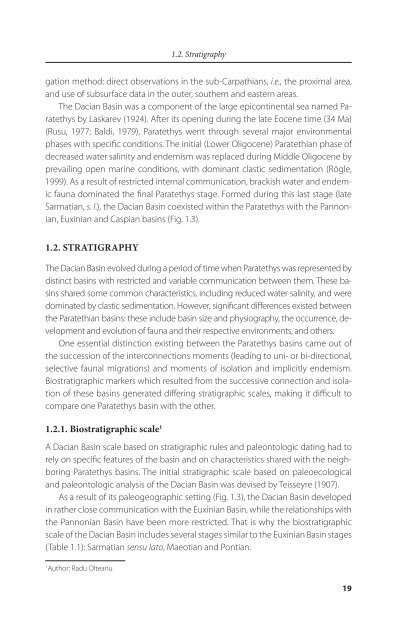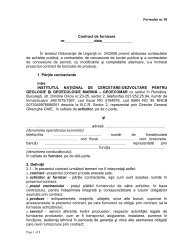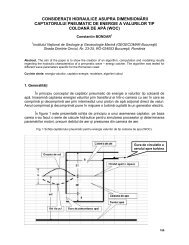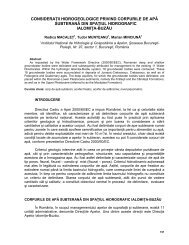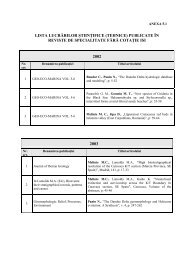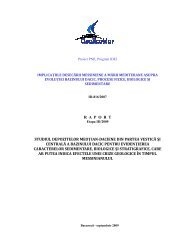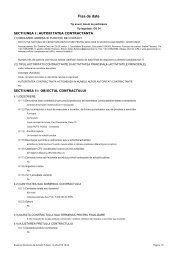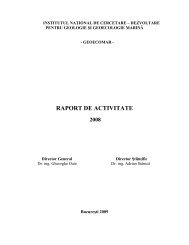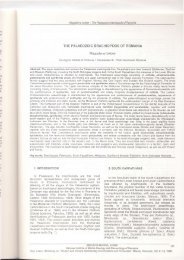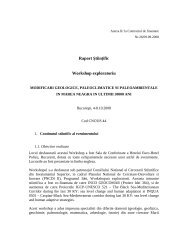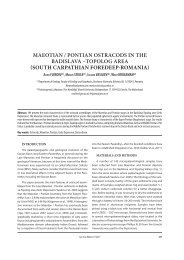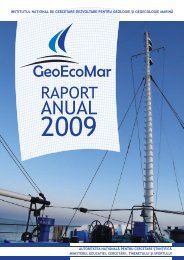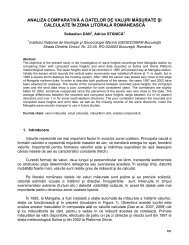DACIAN BASIN - GeoEcoMar
DACIAN BASIN - GeoEcoMar
DACIAN BASIN - GeoEcoMar
Create successful ePaper yourself
Turn your PDF publications into a flip-book with our unique Google optimized e-Paper software.
1.2. Stratigraphy<br />
gation method: direct observations in the sub-Carpathians, i.e., the proximal area,<br />
and use of subsurface data in the outer, southern and eastern areas.<br />
The Dacian Basin was a component of the large epicontinental sea named Paratethys<br />
by Laskarev (1924). After its opening during the late Eocene time (34 Ma)<br />
(Rusu, 1977; Baldi, 1979), Paratethys went through several major environmental<br />
phases with specific conditions. The initial (Lower Oligocene) Paratethian phase of<br />
decreased water salinity and endemism was replaced during Middle Oligocene by<br />
prevailing open marine conditions, with dominant clastic sedimentation (Rögle,<br />
1999). As a result of restricted internal communication, brackish water and endemic<br />
fauna dominated the final Paratethys stage. Formed during this last stage (late<br />
Sarmatian, s. l.), the Dacian Basin coexisted within the Paratethys with the Pannonian,<br />
Euxinian and Caspian basins (Fig. 1.3).<br />
1.2. STRATIgRAPHY<br />
The Dacian Basin evolved during a period of time when Paratethys was represented by<br />
distinct basins with restricted and variable communication between them. These basins<br />
shared some common characteristics, including reduced water salinity, and were<br />
dominated by clastic sedimentation. However, significant differences existed between<br />
the Paratethian basins: these include basin size and physiography, the occurrence, development<br />
and evolution of fauna and their respective environments, and others.<br />
One essential distinction existing between the Paratethys basins came out of<br />
the succession of the interconnections moments (leading to uni- or bi-directional,<br />
selective faunal migrations) and moments of isolation and implicitly endemism.<br />
Biostratigraphic markers which resulted from the successive connection and isolation<br />
of these basins generated differing stratigraphic scales, making it difficult to<br />
compare one Paratethys basin with the other.<br />
1.2.1. Biostratigraphic scale 1<br />
A Dacian Basin scale based on stratigraphic rules and paleontologic dating had to<br />
rely on specific features of the basin and on characteristics shared with the neighboring<br />
Paratethys basins. The initial stratigraphic scale based on paleoecological<br />
and paleontologic analysis of the Dacian Basin was devised by Teisseyre (1907).<br />
As a result of its paleogeographic setting (Fig. 1.3), the Dacian Basin developed<br />
in rather close communication with the Euxinian Basin, while the relationships with<br />
the Pannonian Basin have been more restricted. That is why the biostratigraphic<br />
scale of the Dacian Basin includes several stages similar to the Euxinian Basin stages<br />
(Table 1.1): Sarmatian sensu lato, Maeotian and Pontian.<br />
1 Author: Radu Olteanu<br />
19


